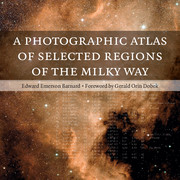Book contents
- Frontmatter
- Contents
- Foreword by Gerald Orin Dobek, FRAS
- Preface from the original Atlas
- ADDENDUM
- BOOK I
- BOOK II
- Catalogue of 349 dark objects in the sky
- Catalogue of 352 dark objects in the sky in J2000.0 co-ordinates
- Photographs, charts, tables and descriptions
- Photographs, charts, tables and descriptions
- Biography of Edward Emerson Barnard by Gerald Orin Dobek
Foreword by Gerald Orin Dobek, FRAS
Published online by Cambridge University Press: 05 June 2012
- Frontmatter
- Contents
- Foreword by Gerald Orin Dobek, FRAS
- Preface from the original Atlas
- ADDENDUM
- BOOK I
- BOOK II
- Catalogue of 349 dark objects in the sky
- Catalogue of 352 dark objects in the sky in J2000.0 co-ordinates
- Photographs, charts, tables and descriptions
- Photographs, charts, tables and descriptions
- Biography of Edward Emerson Barnard by Gerald Orin Dobek
Summary
I WAS twelve years old when I first discovered Edward Emerson Barnard's famous work, A Photographic Atlas of Selected Regions of the Milky Way. In my continued explorations of the life of E. E. Barnard and his work, and through my personal discoveries of the cosmos, I noticed a striking set of parallels between his life and mine that made strong my devotion to his work. We were both born in December exactly 100 years apart: Barnard in 1857 and I in 1957. Barnard came from an impoverished family and grew up in civil unrest and war in America. My beginnings were much the same, and although the civil unrest was in Vietnam, it had permeated into everyday American life. At the age of nine, we both entered the workforce outside the home in an effort to financially assist our families. We both struggled through our education, always keeping a focus on our passion for astronomy. And, like Barnard, I've devoted my life to observational astronomy, with a fanaticism for the dark nebulosity within our Galaxy.
Barnard spent most of his astronomical career photographing the night sky. What he captured in those images provided greater detail than the eye could discern through the telescope. The most interesting regions found in these photographs were dark patches that Barnard called “black holes”; unique objects that are, of course, not the black holes that astronomers refer to today, but masses of dust and gas silhouetted against the brightness of the Milky Way.
- Type
- Chapter
- Information
- Publisher: Cambridge University PressPrint publication year: 2011



